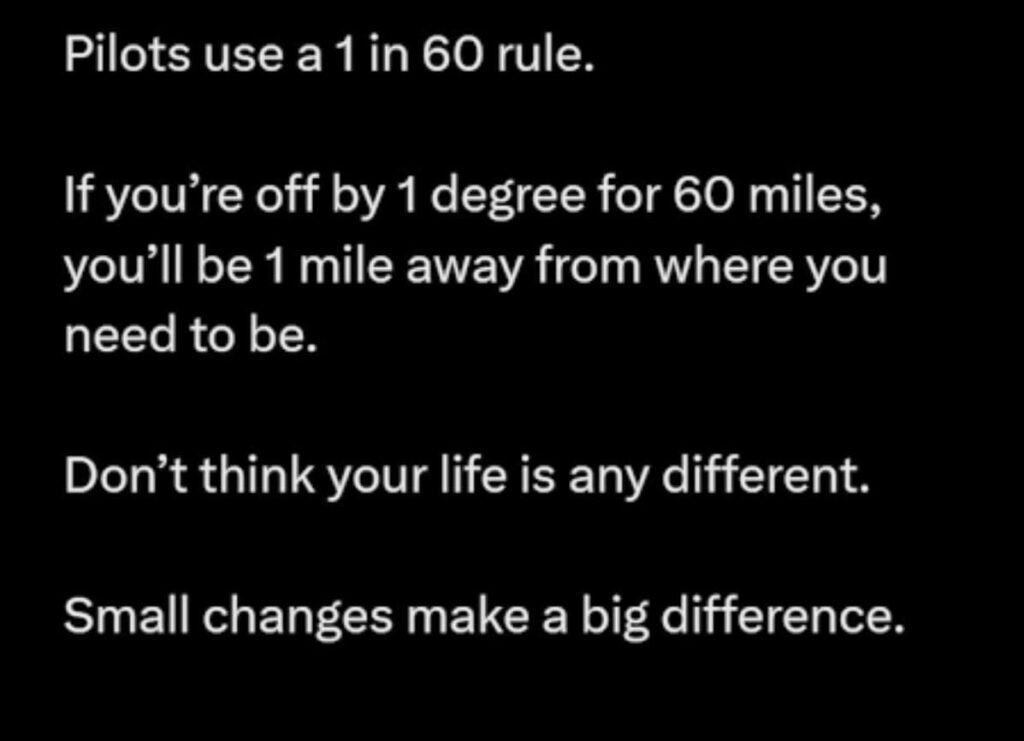26th April 2024
On March 28, 1979, a sightseeing flight crashed into a mountain in Antarctica, killing all of the 279 people on board.
An investigation determined that the crew had not been informed of a two-degree correction made to the plane’s flight path the night before, causing the plane’s navigation system to route them toward Mount Erebus instead of through McMurdo Sound.
Two degrees doesn’t sound like a lot, but in aviation terms, even one degree is huge.
That’s why pilots are taught the 1 in 60 rule, which states that after 60 miles, a one-degree error in heading will result in straying off course by one mile.
Which means the lake you planned to fly over could turn out to be a mountain.
Keep in mind the 1 in 60 rule isn’t just a navigation aid; it’s a mental framework designed to reinforce the importance of making constant course evaluations and corrections.
If you don’t, the farther you go, the more off course you end up.
Which makes the 1 in 60 rule a great mental framework for accomplishing your own goals.
We all have dreams.
The people who accomplish their dreams don’t just dream,They create processes, They build systems, They establish routines that keep them on track and ensure they reach their ultimate goal.
Oddly enough, they don’t obsess over their goals. They obsess over their processes because greatness results partly from inspiration but mostly from consistent, relentless effort.
And they stay on course because they constantly evaluate their progress and make smart corrections to their process.
Want to turn a dream into a reality? Follow this simple process.
Start with an extremely specific goal.
The further off course you start, the further off course you’ll wind up. That’s why setting a specific goal is so important.
Say you want to get in better shape and be healthier. “Be healthier” sounds great, but it’s too vague.
How will you know when you’re “in better shape,” much less, “healthier”?
“Lose 10 pounds in 60 days” is a specific, objective and most critically, measurable goal. You know exactly what you want to accomplish, which means you can create a process designed to get you there. You can create a diet plan & an effective workout plan.
You can monitor your progress and make smart course corrections.
Or say you want to grow your business. “Increase revenue” sounds great but is too vague. “Land five new customers this month” is specific, objective and measurable. You know exactly what you want to accomplish, which means you can create a process designed to get you there.
The Bottom line is that you can’t set an accurate course until you know exactly where you want to go.
One of the biggest reasons people give up on huge goals is the distance between here, where you are today, and there, where you someday hope to be. If you did only ₹1 million in sales last month and your target is ₹ 100 million in sales per month, the distance between here and there seems insurmountable.
That’s one reason most incredibly successful people set a goal and then focus all their attention on creating and following a process designed to achieve that goal. The goal still exists, but their real focus is on what they do today.
And making sure they do it again tomorrow.
Because consistency matters: What you do every day is who you are and who you will become.
Focus on your process is the most important.
Health care providers are taught to check medications three times before delivering to patients. Not because the process itself is complex, but because the consequence of error is so great.
The same is true for you; the consequence of “error,” in terms of time, effort, money, etc., when you don’t achieve a goal can be considerable. and depressing.
No matter how often you hear “fail fast, fail often,” failure still pretty much sucks.
Pilots use the 1 in 60 rule to remind themselves to constantly monitor their progress and make quick course corrections.
You also know where you want to go. But you’ll never get there if you don’t regularly monitor and revise your plan based on your progress.
So don’t just correct your course along the way. Create and follow a process that is proved to work. Pick someone who has achieved something you want to achieve. Deconstruct his or her process.
Then follow it, and along the way, make small corrections as you learn what works best for you.
That way, when you travel your own version of 60 miles, you’ll arrive precisely where you hoped to be.
Always remember the ‘1-in-60 Rule’ & stay blessed forever.

